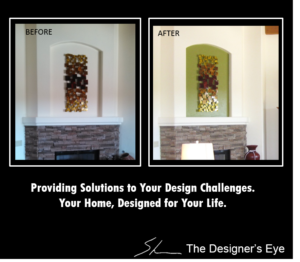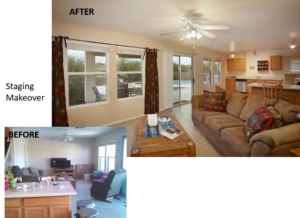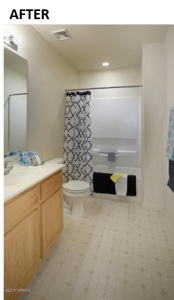Selling Your Home?
Confused about what is most important to do first?
First and most importantly: take a breath and get into the right mindset.
- The biggest favor you can do for yourself is to remember that it’s not about how you live in the home, or your personal style. Staging a home is a very different approach than interior design.
- Next, come to terms with the reality that this is no longer “your home”. It is now a property you own and no longer want to own; an investment you made that needs to be liquidated (sold) in order to free you up for the next phase of your life, whatever that is.
Once you’re clear on that- and it can be a tough challenge!- ask yourself these questions about your home.
ASK:
-
What are the most desirable or popular features of homes today? Does my home meet these expectations?
If yes, great! Play up those aspects of your house by making those features focal points. In other words, make the best features of each room the most noticeable in the room. If you have a fireplace, make sure it’s the most noticeable feature in the space. Unless, of course, there is another feature of the house that is even better, such as a spectacular view.
These are some of the most popular features a home can offer.
Kitchens and bathrooms are always a top feature in homes for sale and so you want them to really sparkle. In other rooms, views, fireplace, finishes, architectural features, and function become very important. Show the buyers exactly what they’re getting when they buy your property. In order of priority, these are the items that you’ll most want to focus on, if your spaces have them.
- Beautiful views (mountain, ocean, forest, etc.) from windows
- Wood beams
- Fireplace
- Columns, plant shelves, soffit lighting, arches, and other architectural features that create interest in a room
- Finishes such wood or specialty finish doors; popular counter tops such as granite or stone; and quality, high-end flooring
When rooms have one or more of these features, your staging job is about making sure those items are highly visible. This can be achieved by clearing excess artwork and furniture out of the rooms, if at all possible. Keep it simple. Show your beautiful furnishings if you have them, because they will continue the staging story for your buyers: that they are in a special home and that people of great taste live in the home. And the buyer wants to be that kind of people too! But be sure that you are not overloading the buyer with your furnishings and design style. Provide empty spaces on walls and floors that allow the buyer to see their own style and how it will fit into the home. Even this simple example of painting the niche in a large white room had a dramatic effect on how visible the fireplace was overall. An easy $15 solution! If you’re intimidated by paint, check out my free paint how-to tip to create clean, crisp lines.

If there is no structural focal point in a room
When a home does not answer these challenges well, you’ve got some work to do to create interest, prove function, and make your home desirable to your buyers! Some rooms don’t have much to say for themselves. Maybe a room is just four walls with no interesting details or angles; maybe there is no view, etc. In that case, your furnishings have to do the job on their own. Without highlighting the negatives, it is possible to highlight the possibilities of a space. Create focal points with artwork and furniture placement to demonstrate that your home is functional, stylish, and comfortable. But always keep in mind that these pieces won’t come with the house, so don’t overload. Less is more in most cases when it comes to staging. We’re not trying to hide the room, we’re trying to show it’s potential.
Working with outdated features or finishes
We can’t all spend thousands of dollars installing new cabinetry, counter tops, flooring, etc. If the home has outdated features, stage to show that your home is clean and comfortable. Demonstrate that it is functional enough to be livable until changes can be made. Adding in new pieces/colors, or using existing from other areas in the home, can make a space feel updated by showing how dated finishes can blend with colors that are currently trending. If you’ve got peach colored counter tops, bring in rusts and browns, creams and deep blues, or other current color trends to make the spaces feel that they can hold their own until the new buyer is ready to make some changes. Sometimes a fresh coat of paint in a neutral color can make outdated woodwork feel trendy, retro, and “edgy”. Give some serious thought to your budget and speak with your realtor and/or staging professional to figure out where your staging budget will have the biggest payoff.
Create cohesive spaces throughout the home with color
My clients are very often surprised by what I can pull together from their closets and accessories scattered throughout their home. Without realizing it, most of us are buying to a specific set of preferences. I staged a home once where blue became the connecting color throughout each of the rooms in the 2800 sf home. The homeowner was shocked to see the end results and discover that everything I’d used was hers, even though we’d agreed I wouldn’t be purchasing anything! Here are some photos of that home. As you can see, the home didn’t have a lot of furnishings set aside for staging, but still tells a great story.



In projects like this, it’s all about removing everything that works against the main color scheme. Remove the excess, remove the overflow of other colors, and you’re left with a cohesive palette that creates calm flow in a home. This is particularly important when selling, because buyers will more easily remember your home if all the spaces connect well through the design palette.
It all comes down to a competition between your house and all others that will be seen. If your home tells the better story, through a skillful combination of pricing and showcasing the home at its best, then your home wins. And when your home wins, you win.
